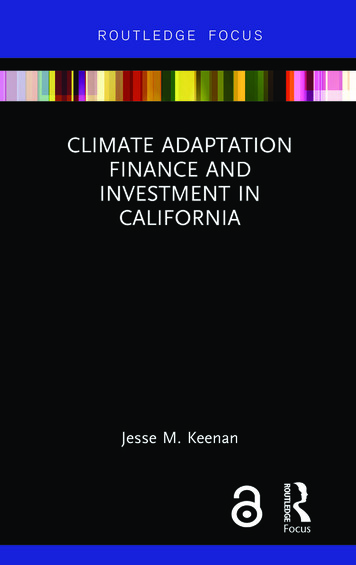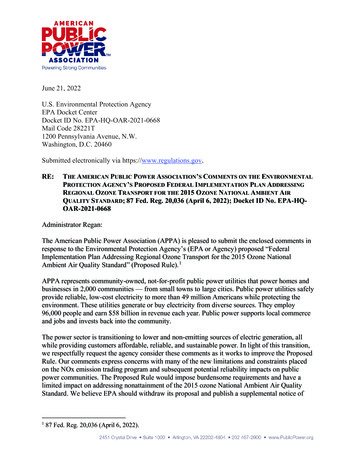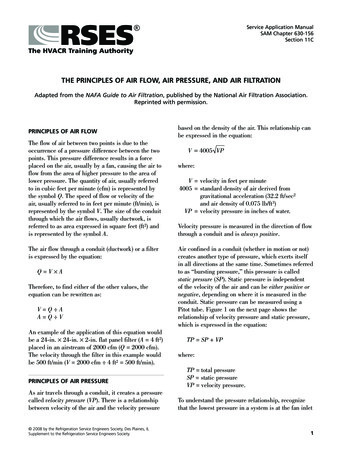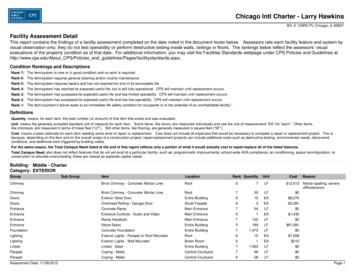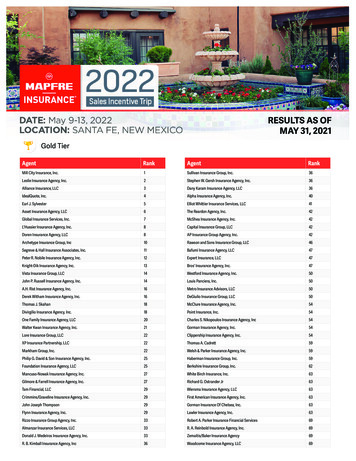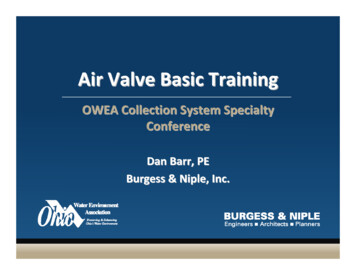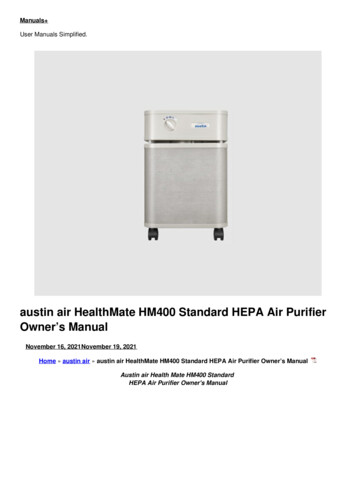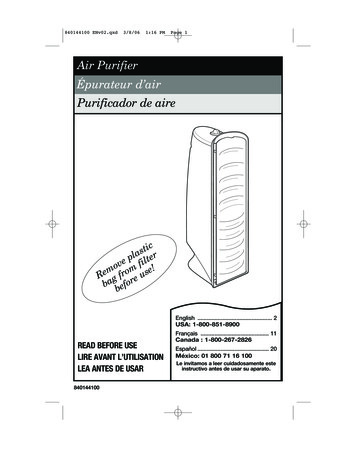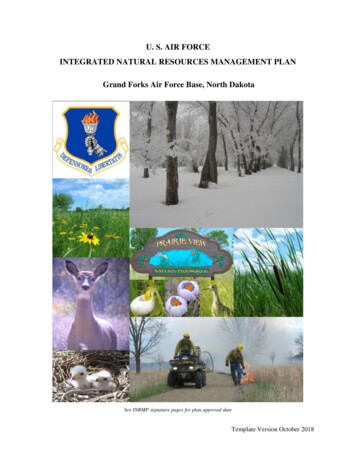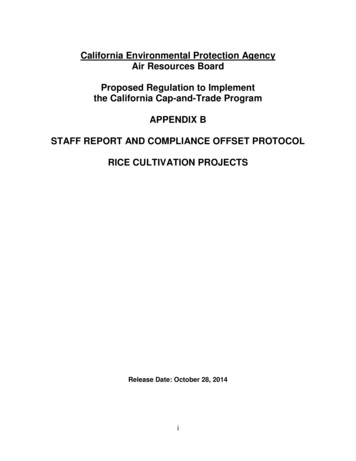
Transcription
California Environmental Protection AgencyAir Resources BoardProposed Regulation to Implementthe California Cap-and-Trade ProgramAPPENDIX BSTAFF REPORT AND COMPLIANCE OFFSET PROTOCOLRICE CULTIVATION PROJECTSRelease Date: October 28, 2014i
This Page Intentionally Left Blankii
State of CaliforniaCalifornia Environmental Protection AgencyAIR RESOURCES BOARDStationary Sources DivisionSTAFF REPORT: INITIAL STATEMENT OF REASONSPROPOSED REGULATION TO IMPLEMENTTHE CALIFORNIA CAP-AND-TRADE PROGRAMAPPENDIX BSTAFF REPORT AND COMPLIANCE OFFSET PROTOCOLRICE CULTIVATIONRICE CULTIVATION PROJECTSPublic Hearing to Consider the Proposed Regulationto Implement the California Cap-and-Trade ProgramDate of Release: October 28, 2014Scheduled for Consideration: December 18-19, 2014Location:California Air Resources BoardByron Sher Auditorium1001 I StreetSacramento, California 95814This report has been reviewed by the staff of the California Air Resources Board andapproved for publication. Approval does not signify that the contents necessarily reflectthe views and policies of the Air Resources Board, nor does mention of trade names orcommercial products constitute endorsement or recommendation for use.iii
This Page Intentionally Left Blankiv
I. INTRODUCTION AND BACKGROUND ON COMPLIANCE OFFSETPROTOCOLSA. Staff ProposalStaff recommends the Board adopt a new Compliance Offset Protocol for RiceCultivation projects to support the offset cost containment mechanism in the CaliforniaCap-and-Trade program. This appendix discusses the development of a ComplianceOffset Protocol for Rice Cultivation projects.B. Rationale for Compliance Offset ProtocolsUnder the Cap-and-Trade Program, covered entities may use ARB offset credits tosatisfy up to eight percent of their compliance obligation. This limit applies to eachindividual covered or opt-in covered entity for each compliance period. ARB offsetcredits are tradable credits that represent verified greenhouse gas (GHG) emissionsreductions or removal enhancements from sources not subject to a complianceobligation in the Cap-and-Trade Program. These offset credits result from one of thefollowing: (1) a project undertaken using an Air Resources Board (ARB or Board)approved Compliance Offset Protocol pursuant to Subarticle 13 of the Cap-and-TradeRegulation; (2) an offset credit issued by a linked jurisdiction pursuant to Subarticle 12of the Cap-and-Trade Regulation; or (3) a sector-based offset credit issued by anapproved sector-based crediting program pursuant to Subarticle 14 of the Cap-andTrade Regulation. These GHG sources are usually outside of the industrial, energy,and transportation sectors.As required by Division 25.5 of the Health and Safety Code (Assembly Bill 32 or AB 32),any reduction of GHG emissions used for compliance purposes must be real,permanent, quantifiable, verifiable, enforceable, and additional (Health and Safety Code§38562(d)(1) and (2)). Any offsets issued by ARB must be quantified according toBoard-approved Compliance Offset Protocols. The Cap-and-Trade Regulation(Regulation) includes provisions for collecting and submitting the appropriate monitoringdocumentation to support the verification and enforcement of reductions realizedthrough the generation and retirement of compliance offset credits. The regulatoryprovisions and the requirements of the Compliance Offset Protocols will ensure thereductions are quantified accurately, represent real GHG emission reductions, and arenot double-counted within the system. Compliance Offset Protocols are consideredregulatory documents and are made publicly available so that anyone interested indeveloping an offset project can do so if the project meets Board-approved standards.1
Cap and Trade App B Rice ISORC. Board Adoption of Compliance Offset ProtocolsAt its October 2011 meeting, the Board adopted four Compliance Offset Protocols,including protocols for Livestock Manure (Digester) Projects, Ozone DepletingSubstances (ODS) Destruction Projects, Urban Forest Projects, and U.S. ForestProjects. Resolution 11-32, adopted by the Board on October 20, 2011, directed theExecutive Officer “to develop implementation documents laying out the process forreview and consideration of new offset protocols, including a description of how staff willevaluate additionality.” This direction signaled the Board’s intention to adopt additionalCompliance Offset Protocols in the future. The Compliance Offset Protocol ReviewProcess document is available at set-protocol-process.pdf. In 2014, the Board adopted a fifth Compliance OffsetProtocol, the Mine Methane Capture Projects protocol, while updates to three existingCompliance Offset Protocols: Livestock Projects, Ozone Depleting Substances Projectsand U.S. Forest Projects are proceeding through the adoption process.D. Compliance Offset Protocol Structure and Regulatory RequirementsCompliance Offset Protocols consist of two main structural elements: projectrequirements and project quantification. Project requirements include items such aseligibility, monitoring and reporting, and verification and enforcement provisions. AB 32requires ARB to adopt regulatory requirements for verification and enforcement of anyoffset reductions used for compliance purposes. Project quantification identifies thequantification methodologies and equations used in project accounting such as baselinedetermination and calculation of emissions and emission reductions.The Cap-and-Trade Regulation includes offset program regulatory requirements, suchas eligibility criteria for start dates, project locations, offset project reporting periods,project document retention, project listing information, project reporting information,verification requirements, and enforcement provisions. Staff has developed theCompliance Offset Protocol for Rice Cultivation Projects to be consistent with regulatoryrequirements in the Cap-and-Trade Regulation. Since Compliance Offset Protocols areused in the context of a compliance program, staff has included language in theproposed Compliance Offset Protocol for Rice Cultivation Projects to refer to theregulatory requirements in the Cap-and-Trade Regulation where needed rather thansplitting the offset protocols into separate documents based on regulatory requirementsand quantification methodologies. In sections that relate directly to a requirement in theCap-and-Trade Regulation, text refers readers to the appropriate section(s) of theRegulation.2
Cap and Trade App B Rice ISORNew Compliance Offset Protocols, including the proposed Compliance Offset Protocolfor Rice Cultivation Projects, will be incorporated by reference into the proposedamendments to the Cap-and-Trade Regulation. This incorporation makes the offsetprotocol document an enforceable regulation. AB 32 exempts quantificationmethodologies from the Administrative Procedure Act (Government Code, section11340 et seq.) (APA). However, those elements of the Compliance Offset Protocol arestill regulatory. The exemption allows future updates to the quantificationmethodologies to be made through a public review and Board adoption process butwithout the need for rulemaking documents. Each Compliance Offset Protocol identifiessections that are considered quantification methodologies and exempt from APArequirements. Any changes to the non-quantification elements of the ComplianceOffset Protocols would be considered a regulatory update subject to the full regulatorydevelopment process.3
Cap and Trade App B Rice ISORII. COMPLIANCE OFFSET PROTOCOL FOR RICE CULTIVATIONPROJECTSA. Role of Rice and Rice Cultivation Activities in Climate ChangeMitigationConventional rice cultivation practices generate anaerobic conditions in flooded ricefields that enhance methane production and emissions. Methane emissions from ricefields account for about 0.1% of total GHG emissions in the United States (FAO, 2007).Rice has been commercially cultivated for over 300 years in the United States. Over80% of rice consumption in the U.S. is domestically grown rice (Ray, 2013). Rice farmsare located in six major rice-producing states, as shown in Figure 1, including theSacramento Valley area in northern California, the Mississippi delta, including theeastern part of Arkansas extending to Missouri and Mississippi; the Gulf coast inLouisiana; and the Gulf coast area in Texas.Figure 1. Rice growing areas in 2012 in the United State. (source:http://www.nass.usda.gov/Charts and Maps/Crops County/ar-pl.asp)4
Cap and Trade App B Rice ISOROver the past 10 years, the total planting area in the United States ranged from 2.6 M to3.5 M acres per year (USDA Agriculture Baseline Data Base). Rice farming providesimportant economic and ecological value in the United States.Flooded rice fields provide an important ecological function as manmade wetlands;however, they are also a source of GHG emissions. The proposed Rice CultivationProtocol quantifies GHG emission reductions from changes in rice cultivation practices(eligible project activities). These proposed eligible project activities meet threeoverarching criteria: (1) reduce GHG emissions; (2) maintain yield; and (3) preservecurrent associated environmental and ecological benefits. To propose effective projectactivities, it is necessary to have a good understanding of the emission mechanisms inthe rice fields; that includes the interaction between the rice plant, microbe,environmental conditions in the soil, and current farming practices in each of thegeographic regions.Methane and nitrous oxide are the two dominant greenhouse gases in rice cultivationpractices. Methanogens produce methane under anaerobic conditions in the rice field.Nitrifying and denitrifying bacteria produce nitrous oxide when there is an absence ofdissolved oxygen, also known as the anoxic condition. Nitrous oxide emissions aresensitive to both fertilizer management and flood duration. This protocol primarilyfocuses on methane emissions and is designed to modify current cultivation practices toreduce methane emissions. Any GHG emission reductions from nitrous oxide or carbondioxide will not be eligible for crediting. In addition, any GHG emission increases fromnitrous oxide or carbon dioxide will be debited from the final GHG emission reductions.Figure 2 provides a schematic illustration on how GHG emissions are produced fromwetlands or flooded rice fields.5
Cap and Trade App B Rice ISORFigure 2. Greenhouse Gas Emissions from Wetlands and Flooded Rice Fields talmicrobiology/research/Wetlands)B. Development of the Compliance Offset Protocol for Rice CultivationProjectsThe process of developing the proposed Rice Cultivation Protocol involved an extensivereview of relevant documents and literature as well as a stakeholder participationprocess that included soliciting input from industry experts, government agencies,project developers, Cap-and-Trade Program covered entities, academia and the publicthrough a series of workshops, technical working group meetings, and small groupdiscussions.6
Cap and Trade App B Rice ISORThe formal Rice Cultivation Protocol stakeholder participation process began on March28, 2013, when ARB staff held a public workshop to discuss the development of twopotential Compliance Offset Protocols, the Mine Methane Capture Projects Protocol,adopted by the Board in April 2014, and the Rice Cultivation Projects Protocol, thesubject of this document. During this public workshop, ARB invited interested membersof the public to participate in a rice cultivation technical working group and in the formalrulemaking process. The technical working group included almost 70 members fromthe following areas: Subject experts from federal, state, and local government including:o Federal agencies: U.S. Department of Agriculture, U.S. Fish and WildlifeService, U.S. Geological Survey;o State agencies: Department of Food and Agriculture, Department of WaterResource, Department of Fish and Wildlife, Department of Public Health,and Rice Commission; ando Local agencies: Mosquito and Vector Control Districts (Sac-Yolo andPlacer);Subject experts from academia including University of Arkansas, University ofCalifornia—Davis, and Mississippi State University;Subject experts from industry and/or private business;Environmental and/or conservation groups;Voluntary registries;Cap-and-Trade Program covered entities;ARB accredited verifiers;Potential offset project operators and/or authorized project designees; andOther interested stakeholders.The technical working group held four meetings in 2013. The meetings includeddiscussion of many topics, including: Rice specific verification techniques;Project aggregation;Common rice cultivation practices by region;Emission quantification simplification and streamlining;Rice straw removal after harvest;Missing data substitution;The use of remote sensing and satellite images for record keeping andverification;7
Cap and Trade App B Rice ISOR The DeNitrification-DeComposition (DNDC) model validation and calibrationreview;Structural uncertainty;Soil sampling techniques; andPotential adverse environmental impacts resulting from implementing a project.As part of its development of this protocol, ARB staff reviewed existing voluntary marketoffset protocols to evaluate their scope, additionality provisions, GHG assessmentboundary, quantification methodologies, and requirements for monitoring, reporting, andverification. ARB staff also reviewed documents related to GHG emissions from ricecultivation practices and related biological values as wildlife habitats. These documentsare included in the reference section of this staff report, and are cited when relied uponfor facts. The proposed Rice Cultivation Protocol incorporates elements from many ofthe existing voluntary methodologies as well as the best available science andinformation to ensure that emission reductions are real, permanent, quantifiable,additional, verifiable and enforceable.ARB staff held another public workshop in March 2014 to provide a discussion draft ofthe proposed Rice Cultivation Protocol for public review and comment. Staff receivedcomments from 57 entities on this discussion draft. Staff also had individual interactionswith stakeholders interested in discussing protocol related issues, and the staff proposalreflects those discussions. Staff considered all comments and incorporated them to theextent applicable and held a subsequent workshop on June 20, 2014 to discuss theproposed protocol. A revised draft version of the proposed Rice Cultivation Protocolwas also made publicly available for this workshop.ARB staff solicited and incorporated input from stakeholders into the proposed finalversion for Board consideration released with this staff report for public review onOctober 28, 2014. The formal 45-day public comment period begins onOctober 31, 2014 and the new Compliance Offset Protocol will be considered at theDecember 18 and 19, 2014 Board hearing with the proposed amendments to theCap-and-Trade Regulation.C. Description of the Compliance Offset Protocol for Rice CultivationProjects1.OverviewARB’s proposed Rice Cultivation Protocol incentivizes the reduction of GHG emissionsresulting from rice cultivation activities in the United States. The proposed Rice8
Cap and Trade App B Rice ISORCultivation Protocol will allow for the issuance of compliance offset credits for emissionreductions achieved by switching to lower GHG emission rice cultivation practices thatreduce methane emissions that would otherwise be released into the atmosphere as aresult of conventional rice cultivation activities. The proposed Rice Cultivation Protocolis applicable to projects within the United States. The proposed Rice CultivationProtocol requires the use of the DNDC model, which has only been calibrated for thetwo rice-growing regions identified in the protocol based on available data.The two Rice Growing Regions in the United States are: California Rice Growing Region: comprises rice growing areas in the SacramentoValley; andMid-South Rice Growing Region: comprises the following areas in the Mid-Southstates:o The Mississippi Delta: Includes eastern part of Arkansas, the southernportion of Missouri, and the western part of the Mississippi; ando The Gulf Coast of Louisiana.The proposed Rice Cultivation Protocol allows for three types of project activities basedon the currently available calibrated and validated DNDC model and business-as-usualpractices as discussed in section II.C.2. below: Switch from wet seeding to dry seeding (eligible in the California Rice GrowingRegion only);Alternate wetting and drying (eligible in the Mid-South Rice Growing Region only);andEarly drainage in preparation for harvest (eligible in both Rice Growing Regions).An explanation of the limitations for the different project activities is included below.Switching from wet-seeding to dry-seeding means changing the seeding method fromsowing dry or soaked seed into flooded fields to drilling or broadcasting dry orgerminated seeds onto dry or moist fields.Alternate wetting and drying is a change to continuous flooding practices after thedevelopment of a 4-5 leaf stage when cyclic wetting and drying of the field occurs. Forevery cycle of wetting and drying, the field will be irrigated but not necessarily flooded. Itis important for fields employing this practice to always keep the soil moisture levelabove 50% to ensure necessary water uptake and maintain a normal yield. For eachdrying event, methane emissions will decrease and nitrous oxide emission will increase.9
Cap and Trade App B Rice ISORThe protocol does not credit any emission reductions for nitrous oxide or carbon dioxide.In addition, the protocol debits any increase in nitrous oxide or carbon dioxide emissions.Early drainage in preparation for harvest means the field will be drained 7-10 days earlierthan a normal drainage schedule. The proposed Rice Cultivation Protocol ensures thatfarmers do not drain the rice fields too early because that could harm crop yield. Theprotocol requires that in California standing water must be present at least 24 days afterfifty-percent heading or 26 days after forty-percent heading; and in the Mid-South Regionat least one grain on the main stem panicle must have a yellow hull before drainagebegins. The draining events for all farmers within each rice-growing region will not fall onthe same day because farmers plant on different days. All draining events in each ricegrowing region should happen within in a four to six week window. Therefore, even withearly drainage events taking place in some fields, these fields may not be the first onesto drain in that rice-growing region. The proposed Rice Cultivation Protocol incorporatesthe following precautionary approaches to ensure the current environmental andecological benefits are preserved. For wildlife conservation purposes in the California Rice Growing Region, no morethan 90% of a participating field’s perimeter may be shared with a public road, afield that is also employing early drainage activities or land zoned for commercial,industrial, residential, planning, special, or mixed use to be eligible for crediting.This restriction protects any remaining flightless late broods that still use floodedrice fields as habitat. The proposed Rice Cultivation Protocol prohibits fields whose tail water flowsdirectly into a natural wetland that has no standing water at the beginning of thedrainage and does not pass through another rice field, drain canal, or irrigationcanal first, from receiving offset credits. This ensures that no increased naturalwetlands from early drained water are created, which could increase methaneemissions or create mosquito habitats.To further protect wildlife habitats, the proposed Rice Cultivation Protocol excludes theButte Sink Wildlife Management Area in the Sacramento Valley. This exclusion ensuresthe Butte Sink Wildlife Management Area and its important wildlife habitat is unaffectedby the implementation of any rice cultivation projects.All three eligible project activities reduce the formation and emission of methane fromflooded rice fields by reducing the duration of flooding. Project activities will varydepending on the rice field’s location and the Offset Project Operator’s discretion. For aproject comprising multiple fields, the Offset Project Operator may employ different10
Cap and Trade App B Rice ISORactivities on each field. The project operator may also choose to rotate and/or changethe project activities within a crediting period.Voluntary protocols included one additional project activity referred to as baling. Inbaling projects, rice straw is removed from the fields after harvest. Staff reviewed thisoption and determined that there was not enough information to make a determination asto the potential adverse environmental impact from the removal of the rice straw.In California, winter flooding became a business-as-usual practice after the passage ofConnelly-Areias-Chandler Rice Straw Burning Reduction Act of 1991. Winter floodedrice fields in California serve as manmade wetlands and are an important wildlife habitatfor many avian and aquatic species. The Sacramento Valley is located on the PacificAmericas Flyway for migratory birds. The Mid-South Rice Growing Region is also acritical bird habitat being located on the Mississippi Americas Flyway. It is crucial toensure that the current wildlife habitat dynamics are not adversely affected by theproposed Rice Cultivation Protocol.Stakeholders also provided comments and information in support and in opposition tobaling. In the abundance of caution, staff has determined additional time andinformation is needed to accurately assess the impacts of baling on the environment andwildlife. While staff is not proposing to add this project activity to the currently proposedcompliance offset protocol, staff will continue to review and evaluate information andpropose the addition of this project activity, if warranted, in a future update to theprotocol.As proposed, the Rice Cultivation Protocol provides project definitions, eligibility rules,conservative GHG emission reduction quantification methodologies, and procedures foroffset project monitoring, reporting, and verification. All projects that pass the eligibilityrequirements set forth in the proposed Rice Cultivation Protocol and the Cap-and-TradeRegulation are eligible to register GHG emission reductions for the duration of the projectcrediting period, which is ten reporting periods.2.AdditionalityAB 32 and the Cap-and-Trade Regulation require emission reductions achieved underCompliance Offset Protocols to be additional to what would have occurred in theabsence of the project in a conservative business-as-usual scenario. The proposedRice Cultivation Protocol ensures compliance with the Regulation’s additionalityrequirement through a performance standard evaluation and assessment of legalrequirements. This approach is similar to the Compliance Offset Protocols approved by11
Cap and Trade App B Rice ISORthe Board in 2011 and 2014, which also ensured additionality by utilizing a regulatoryadditionality requirement and a performance standard approach. The performancestandard is an identified standard of performance applicable to all Rice Cultivationprojects. A performance standard establishes a threshold for greenhouse gasemissions that is significantly better than average, business-as-usual greenhouse gas(GHG) emissions for a specified activity. If a project developer meets or exceeds thestandard, the project satisfies the criterion of “additionality.” If the project meets thethreshold, then it exceeds what would happen under the business-as-usual scenarioand generates additional GHG reductions.Unlike the previous Board adopted Compliance Offset Protocols, due to differingagricultural practices in the two rice growing regions as a result of differing soils,climate, water availability, cultivation practices, cultivars and other factors, it isappropriate to evaluate the performance standard for the proposed Rice CultivationProtocol for each activity type and each rice growing region independently. In additionto the performance standard, projects must show regulatory additionality. Regulatoryadditionality, in this instance, means that there are no federal, state or local laws,regulations or legally binding mandates requiring the project activities in the protocolthat would result in a reduction of methane emissions. In addition, projects must complywith all applicable local, state, and federal laws and regulations, including air and waterquality, pesticide and herbicide use, fertilizer use, energy regulations, or others imposedby any local, state or federal agency with authority over the project.Performance Standard Evaluation for Switching from Wet Seeding to Dry SeedingBased on ARB staff’s review of the existing literature and discussions with the technicalworking group described in section II.B., very few rice fields in California employ dryseeding due to weed (e.g. red rice) control (USDA NIFA, 1998; Carol, 2009; Cline,2003). Therefore, ARB does not consider dry seeding to be business-as-usual inCalifornia. Dry seeding in the California Rice Growing region is additional because it isnot used prevalently in California, and is an eligible project activity under the proposedRice Cultivation Protocol.However, in the Mid-South Rice Growing Region, where crop rotation provides someweed control benefits, dry seeding is the predominant seeding method (McCauley,2012). According to University of Arkansas Rice Production Handbook (Kumar &Ladha, 2013), dry seeding is practiced on about 94 percent of the Arkansas riceacreage. Dry seeding normally involves less land preparation which has somebeneficial effects, such as lowering production costs, generating more profit per acre,requiring less labor demand (the same labor handles more acres), and less wear on12
Cap and Trade App B Rice ISORequipment (Smith, 2005; LSU, 2000). Based on ARB staff’s review of the existingpractices, dry seeding is considered to be business-as-usual in the Mid-South RiceGrowing Region. Dry seeding in the Mid-South Rice Growing Region is not consideredadditional and is not an eligible project activity under the proposed Rice CultivationProtocol.Performance Standard Evaluation for Alternate Wetting and DryingBased on ARB staff’s review of the existing literature and discussions with the technicalworking group described in section II.B., very few rice fields in either California or MidSouth practice alternate wetting and drying (Anders, 2012; Saichuk , 2009; Hardke,2014). Alternate wetting and drying requires constant monitoring of soil moisture toensure adequate water for a crop’s water uptake requirements and does not have thepotential to increase crop yield. Therefore, rice farmers normally do not employ suchpractice because of increased labor/management costs. Alternate wetting and drying isnot considered business-as-usual in either California or the Mid-South Regions.However, alternate wetting and drying is only an eligible project activity in the Mid-SouthRice Growing Region under the proposed Rice Cultivation Protocol because the DNDCmodel has not been validated for this activity in the California Rice Growing Region. Ifvalidation of the DNDC model for alternate wetting and drying occurs in the future, ARBwill consider adding it as an eligible project activity.Performance Standard Evaluation for Early Drainage in Preparation for HarvestBased on ARB staff’s review of the existing literature and discussions with the technicalworking group described in section II.B., very few rice fields in either California or theMid-South adopt early drainage in preparation for harvest (Champagne et al, 2005;Counce, 2009). Early drainage cannot increase yield and draining too early can actuallyreduce yield, which is why the protocol specifically includes drainage criteria to maintainyield. Early drainage in preparation for harvest is not considered to be business-asusual in either California or Mid-South. Early drainage in both the California and theMid-South Rice Growing regions is considered additional and is an eligible projectactivity under the proposed Rice Cultivation Protocol.Legal RequirementsEmission reductions achieved by a Rice Cultivation project must also exceed thoserequired by any law, regulation, or legally binding mandate at the time of offset projectcommencement. If no law, regulation, or legally binding mandate requiring the adoptionof any project activity in the region where the project is located exists at the time of13
Cap and Trade App B Rice ISORoffset project commencement, methane emission reductions caused by a change in ricecultivation practices are eligible for crediting under this proposed Protocol, subject to theperformance standard evaluation above. If any law, regulation, or legally bindingmandate requiring the reduction of methane from rice fields where the project is locatedexists at the time of offset project commencement, methane emission reductions inexcess of what is legally required is eligible for crediting under this Protocol, subject tothe performance standard evaluation as described above.With the recent experience of record drought in California, ARB has recognized theneed to ensure that temporary mandated emergency measures are treated differentlythan permanent laws and regulations when assessing legal requirements foradditionality and when determining the baseline scenario. Therefore, staff proposesthat, if a federal, or state official mandates an emergency temporary law or measureresulting in a change of rice cultivation practices, projects can still meet the regulatoryadditionality requirement
Sacramento Valley area in northern California, the Mississippi delta, including the eastern part of Arkansas extending to Missouri and Mississippi; the Gulf coast in Louisiana; and the Gulf coast area in Texas. Figure 1. Rice growing areas in 2012 in the United State. (source:
